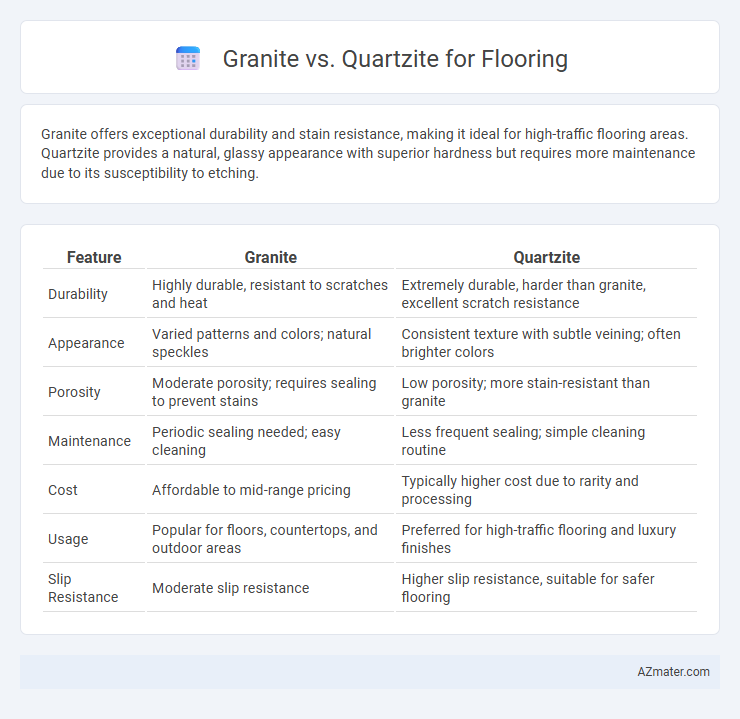Granite offers exceptional durability and stain resistance, making it ideal for high-traffic flooring areas. Quartzite provides a natural, glassy appearance with superior hardness but requires more maintenance due to its susceptibility to etching.
Table of Comparison
| Feature | Granite | Quartzite |
|---|---|---|
| Durability | Highly durable, resistant to scratches and heat | Extremely durable, harder than granite, excellent scratch resistance |
| Appearance | Varied patterns and colors; natural speckles | Consistent texture with subtle veining; often brighter colors |
| Porosity | Moderate porosity; requires sealing to prevent stains | Low porosity; more stain-resistant than granite |
| Maintenance | Periodic sealing needed; easy cleaning | Less frequent sealing; simple cleaning routine |
| Cost | Affordable to mid-range pricing | Typically higher cost due to rarity and processing |
| Usage | Popular for floors, countertops, and outdoor areas | Preferred for high-traffic flooring and luxury finishes |
| Slip Resistance | Moderate slip resistance | Higher slip resistance, suitable for safer flooring |
Introduction to Granite and Quartzite Flooring
Granite flooring is a natural stone known for its durability, resistance to scratches, and wide range of colors, making it a popular choice for high-traffic areas. Quartzite flooring, formed from sandstone and metamorphosed into a dense, hard stone, offers exceptional hardness and a glassy appearance with unique veining patterns. Both materials provide excellent longevity and aesthetic appeal, with granite typically being more stain-resistant and quartzite prized for its natural shine and sophisticated look.
Key Differences Between Granite and Quartzite
Granite flooring is typically composed of igneous rock with a coarse-grained texture, offering exceptional durability and resistance to scratches and heat. Quartzite, a metamorphic rock formed from sandstone, is denser and harder than granite, providing superior scratch resistance and a more glassy luster. Key differences include granite's varied color patterns and quartzite's generally lighter, more uniform appearance, alongside quartzite's slightly higher cost due to its rarity and mining difficulty.
Appearance and Aesthetic Appeal
Granite floors showcase a speckled, granular appearance with natural variations in color and pattern, offering robust, timeless elegance ideal for both traditional and contemporary interiors. Quartzite floors exhibit a more uniform, glassy surface with subtle veining and a marble-like luster, providing a sophisticated, high-end aesthetic that enhances modern design schemes. Both materials bring distinctive textures and hues, allowing homeowners to choose between the bold, intricate patterning of granite and the sleek, refined look of quartzite for flooring.
Durability and Hardness Comparison
Granite exhibits exceptional durability with a Mohs hardness rating of 6-7, making it highly resistant to scratches, chips, and daily wear, which is ideal for high-traffic flooring areas. Quartzite surpasses granite in hardness, scoring between 7-8 on the Mohs scale, offering superior scratch resistance and robustness against impact, ensuring long-lasting floor performance. Both materials deliver strong resistance to heat and stains, but quartzite's enhanced hardness makes it a preferred choice for flooring projects demanding maximum durability.
Resistance to Stains and Scratches
Granite offers exceptional resistance to scratches due to its natural hardness rating of 6-7 on the Mohs scale, making it highly durable for flooring in high-traffic areas. Quartzite, with a hardness rating of 7-8, is even more resistant to abrasion and mechanical damage, providing superior performance against scratches. Both materials exhibit excellent resistance to stains when properly sealed, but quartzite's dense, non-porous nature gives it a slight advantage in preventing liquid penetration and discoloration over time.
Maintenance and Cleaning Requirements
Granite flooring requires regular sealing every 1-2 years to maintain its stain resistance and prevent moisture penetration, while quartzite, being naturally more durable and less porous, demands less frequent sealing. Both materials benefit from routine cleaning with pH-neutral, non-abrasive cleaners to avoid surface etching or dullness. Quartzite's higher resistance to scratches and acids makes it easier to maintain in high-traffic areas compared to granite, which may show wear more quickly without proper care.
Installation Process and Challenges
Granite flooring installation demands precise cutting and heavy machinery due to its hardness, often requiring professional expertise to avoid cracking and ensure proper sealing against moisture. Quartzite, harder and denser than granite, presents greater challenges with cutting and polishing, necessitating specialized tools like diamond blades and advanced skill for a flawless finish. Both materials require meticulous subfloor preparation and sealing, but quartzite's higher cost and installation complexity make it less common despite its superior durability.
Cost Comparison: Granite vs Quartzite
Granite flooring typically costs between $40 to $100 per square foot, including installation, making it a mid-range option for durable natural stone floors. Quartzite flooring, often priced higher at $70 to $120 per square foot, reflects its greater hardness and rarity, which contributes to increased material and labor costs. Both materials offer long-lasting performance, but granite provides more affordable options for budget-conscious projects without sacrificing natural beauty.
Environmental Impact and Sustainability
Granite flooring is a natural, durable stone with a lower environmental footprint due to its widespread availability and minimal processing requirements. Quartzite, while also natural and highly resilient, often involves more intensive quarrying and transport processes, contributing to a higher carbon footprint. Both materials are recyclable and long-lasting, but granite generally offers a more sustainable choice for eco-conscious flooring projects.
Which is Best for Your Flooring Needs?
Quartzite offers superior hardness and scratch resistance compared to granite, making it ideal for high-traffic flooring areas. Granite provides a wider range of color options and patterns, appealing to diverse design preferences while offering excellent durability. For flooring needs, quartzite is best for extreme durability and minimal maintenance, whereas granite suits those seeking aesthetic variety combined with strong performance.

Infographic: Granite vs Quartzite for Flooring
 azmater.com
azmater.com